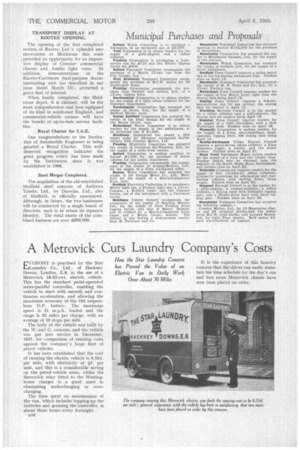Metrovick Cuts Laundry Company's Costs
Page 50

If you've noticed an error in this article please click here to report it so we can fix it.
ECONOMY is practised by the Star Laundry Co., Ltd., of Hackney Downs, London, E.8, in the use of a Metrovick 18-22-cwt, electric vehicle. This has the standard pedal-operated series-parallel controller, enabling the vehicle to start with smooth and continuous acceleration, and allowing the maximum economy of the 193 amperehour D.P. battery. The maximum speed is 21 m.p.h. loaded and the range is 32 miles per charge, with an average of 10 stops per mile.
The body of the vehicle was built by the W. and G. concern, and the vehicle was put into service in December, 1937, for comparison of running costs against the company's large fleet of petrol vehicles.
It has been established that the cost of running the electric vehicle is 0.55d. per mile, with electricity at id. per unit, and this is a considerable saving on the petrol-vehicle costs, whilst the Metrovick relay fitted to the Westinghouse charger is a great asset in eliminating undercharging or .overcharging.
The time spent on maintenance of the van, which includes topping-up the batteries and greasing the controller, is about three hours every fortnight.
alli
How the Star Laundry Concern has Proved the Value of an Electric Van in Daily Work Over About 30 Miles
It is the experience of this laundry concern that the driver can easily maintain his time schedule for the day's run and two more Metrovick chassis have now been placed on order,






















































































































